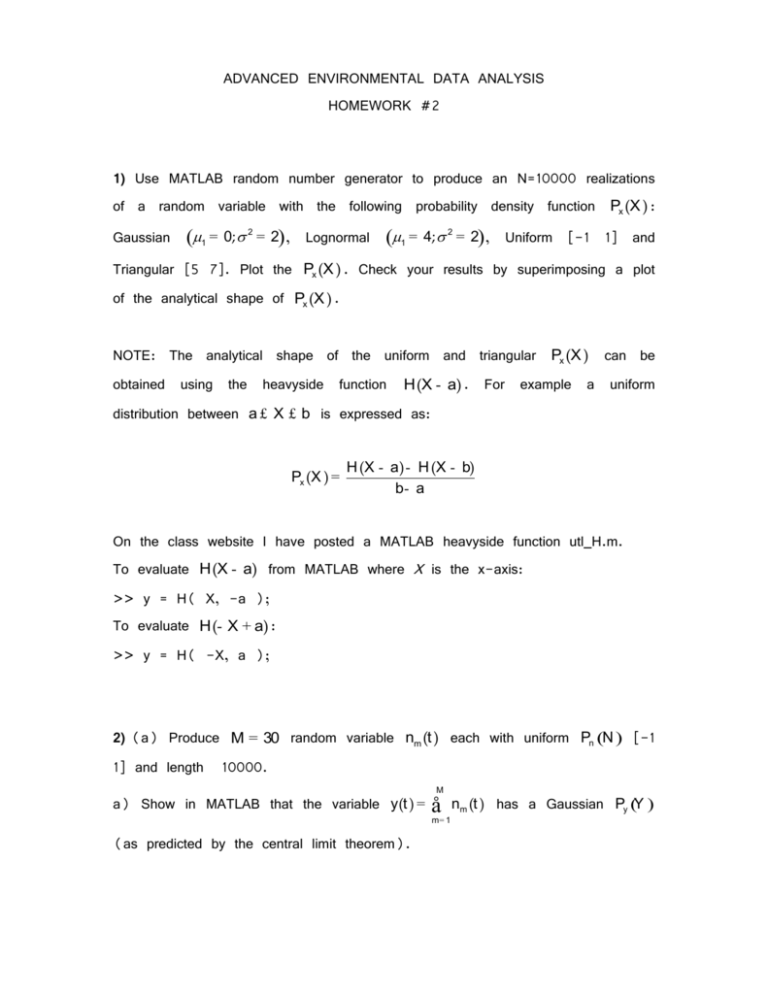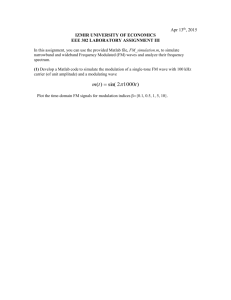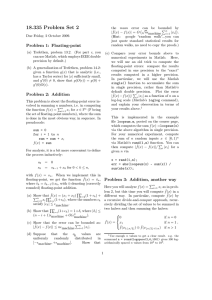Prove that the moments of a random variable x with a gaussian
advertisement

ADVANCED ENVIRONMENTAL DATA ANALYSIS HOMEWORK #2 1) Use MATLAB random number generator to produce an N=10000 realizations of a random variable with the following probability density function Gaussian (1 = 0; 2 = 2) , Lognormal (1 = 4; 2 = 2), Px (X ) : Uniform [-1 1] and Triangular [5 7]. Plot the Px (X ) . Check your results by superimposing a plot of the analytical shape of Px (X ) . NOTE: The analytical shape of the uniform and triangular obtained using the heavyside function H (X - a) . For Px (X ) example a can be uniform distribution between a £ X £ b is expressed as: Px (X ) = H (X - a ) - H (X - b) b- a On the class website I have posted a MATLAB heavyside function utl_H.m. To evaluate H (X - a) from MATLAB where X is the x-axis: >> y = H( X, -a ); To evaluate H (- X + a) : >> y = H( -X, a ); 2) (a) Produce M = 30 random variable nm (t ) each with uniform Pn (N ) [-1 1] and length 10000. a) Show in MATLAB that the variable y(t ) = M å m= 1 (as predicted by the central limit theorem). nm (t ) has a Gaussian Py (Y ) b) Now assume Pn (N ) is Gaussian Pz (Z ) of the variable z(t ) = M å (1 = 0; 2 = 1) . nm2 (t ) . Verify that Compute in MATLAB Pz (Z ) is a chi-square m= 1 distribution by superimposing a plot of the analytical shape. 3) Now assume that you have measured a random variable x(t ) along with its statistics. You find that Px (X ) is a uniform distribution between [-1 1] and that each value of x(ti ) is independent of each other (in other words x(t ) has no autocorrelation in time). What are the statistics of the variable y(t ) given by the following equation: y(t ) = dx dt HINT: Remember that you can discretize the equation y(t i ) = x(t i + 1 ) - x(t i ) and dt that x(ti + 1 ) and x(ti ) can be considered independent random variables with known Px (X ) = Pxi (X i ) = Pxi + 1 (X i + 1 ). If you have trouble with the math, find the Py (Y ) numerically using MATLAB. Once you know the shape of it try to see if you can derive the same result analytically. 4) In class we have quantified the linear relationship between two variables x ' and y' with x' = y' = 0, using the correlation coefficient. If a linear relationship exists, than one could write a statistical optimal linear estimator by imposing the following model (see chap. 3 Davis on class website): yˆ ¢= x ¢ where = x ¢y ¢ x ¢2 This fundamental result can be obtained using the least square approach and minimizing M J= å i=1 the M ni2 = å (y ¢i expected 2 xi¢) value J of the cost function with respect to , where n = y¢- yˆ¢= y¢- x¢ is the i=1 residual between the model estimate ŷ ¢ and the observed value y ¢. Show analytically or numerically that when the model errors ni are normally distributed, the estimate ŷ ¢= x ¢ is equivalent to the estimate obtained using the conditional probability density function yˆ ¢= x ¢= ò +¥ - ¥ Y ¢ Py|x (Y ¢|X ¢= x ¢)dY ¢ Now show that this is no longer true when the errors are lognormally distributed. 5) Download the MATLAB function hw2_generate_Y.m and bs_rand.m. This function will generate 4 different sets of observations of a variable y along with the standard deviation of the measurement error n . a) Using the least square approach and chi-square statistics, test which of the two models y(t ) = a + bt + n(t ) and y(t ) = a + bt + ct 2 + n (t ) is consistent with each of the observational data sets. Compute the uncertainty of the model parameters. In MATLAB to generate a realization for set number one >> set_number = 1; >> [y,t,n_std] = hw2_generate_Y(set_number); You can generate many realizations of data set number one by just calling this function over and over again. You will need to do this to test the chi-square statistics of the cost function J = M å n (t i )2 . i=1 You will do the same test for observational set number 2, 3 and 4. >> set_number = 2; >> [y,t,n_std] = hw2_generate_Y(set_number); b) Explain why the expected value of J is inferred by chi-square statistics. J = ò +¥ - ¥ J PJ (J )dJ where PJ (J ) = chi - square(r ) and r is the degrees of freedom. OPTIONAL STUDY PROBLEMS- NOT REQUIRED 1) Prove that the moments of a random variable x with a Gaussian Px (X ) can be determined only by the mean m1 and the variance 2 . Compute also the value of m3 . Px (X ) = 2) Random variable X has é (X - m )2 ù 1 1 ú exp êê2 údX 2 2 êë ú û Px (X ) = (X 2 - 2 ) . Compute the probability density function of the two new random variables Y and Z defined as: Y = 1 (X 1 + X 2 ) 3 Z= X 1X 2 2 where X n are assumed to be independent realizations of the random variable X.






